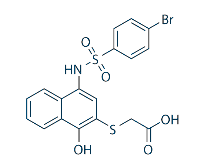Apoptosis
There are many forms of cell death, most of which can be triggered by a variety of stimuli and physiological conditions. The often compared are apoptosis and necrosis. Apoptosis has become the focus of research area due to its complex nature and the different roles of maintaining healthy and self-sustaining biological entities. On the other hand, necrosis is a form of cell damage against acute external injury and trauma, leading to passive cell death and causing an inflammatory response. [1]
The BCl-2 family has been identified as its important role in apoptosis. The BH domain promotes interaction of family members with one another and may be indicative of pro-apoptotic or anti-apoptotic functions. Usually the BCL-2 family have been classified into one of three subfamilies; anti-apoptosis, BH3 only (pro-apoptotic) and pro-apoptotic proteins. The great promise for cancer therapy has been shown in recent research about BCL-2 targeting.[2]
In the cell cycle, apoptosis acts as a fail-safe measure to prevent fidelity and proliferation quality. Although a certain degree of genetic variation is allowed and evolution is promoted, regenerative cells with extensive genetic errors and cell damage are subject to apoptosis. P53 is the Key role in the cell cycle system which initiate the apoptosis in certain cell types. P53 is a widely studied tumor suppressor. The p53 tumor suppressor gene is most frequently mutated in cancer cells (mutation occurs in more than 50% of human cancers) [3], which makes the restriction mechanism ineffective. Tumorigenesis is likely to commence when the p53-based preventive system loses its function completely.
Expression of stimuli, such as DNA damage, hypoxia and activation of certain oncoproteins (eg, Myc, Ras) are dependent on the apoptotic pathway of p53 [4]. The transactivation function of p53 plays an important role in inducing apoptosis, the pro-apoptotic proteins, Bax and lgF-Bp3, are transcriptional targets of p53.[5] As a well-known tumor suppressor, p53 is recognized for its ability to initiate apoptosis in the cell cycle and its ability to induce cell arrest and DNA repair in regenerative cells. In addition to p53, there are many other cell cycle regulators that can affect apoptosis (eg, pRb, p21).
Many studies have emphasized the importance of apoptosis in the self-defense mechanism or immune system. The immune system is responsible for rendering the host resistant to a variety of external pathogens. Apoptosis is an integral part of the immune system and helps maintain the homeostasis of the immune system. Secondly, the immune system relies on apoptosis to eliminate unwanted functional maturation of T cells and B cells [6]. Finally, apoptosis confers cytotoxicity to certain cell types (ie, cytotoxic T lymphocytes and natural killer cells). A well-coordinated disruption protocol allows these cells to destroy target cells while the target cells remain intact. Cytotoxic T lymphocytes (CTLs) can induce target cell death in two ways, one of which involves perforin and granzymes.
- Majno G. and Joris I. (1995) Apoptosis, oncosis, and necrosis. An overview of cell death. Am. J. Pathol. 146, 3–15
- Zhiqing Liu, et al. Drug Discov Today. 2016 Jun; 21(6): 989–996.
- Wang X.W. and Harris C.C. (1997) p53 tumor-suppressor gene: clues to molecular carcinogenesis. J. Cell. Physiol. 173, 247–255 10.1002/(SICI)1097-4652(199711)173:2%3c247::AID-JCP30%3e3.0.CO;2-A.
- Levine A.J. (1997) p53, the cellular gatekeeper for growth and division. Cell 88, 323–331 10.1016/S0092-8674(00)81871-1.
- Owen-Schaub LB,et al. Owen-Schaub LB,Wild-type human p53 and a temperature-sensitive mutant induce Fas/APO-1 expression. Mol Cell Biol. 1995 Jun; 15(6):3032-40.
- Russell J.H. (1995) Activation-induced death of mature T cells in the regulation of immune responses. Curr. Opin. Immunol. 7, 382–388 10.1016/0952-7915(95)80114-6.
-
ABT-263 (Navitoclax)
Catalog No. A10022 Bcl-2 抑制剂ABT-263 (Navitoclax)是一种有效的Bcl-2家族抑制剂 (Bcl-2,Bcl-xL和Bcl-w的Ki <1 nmol/L)。ABT-263对Bcl- xL,Bcl-2和Bcl-w,( Ki≤1nmol/ L) 维持高亲和力,但与Mcl-1和A1的结合更弱。 了解更多 -
Obatoclax mesylate (GX15-070)
Catalog No. A10665 Bcl-2 抑制剂Obatoclax Mesylate (GX15-070)是一种Bcl-2拮抗剂,拮抗所有抗凋亡Bcl-2家族蛋白(平均IC50,3 umol/L),包括Mcl-1(IC50,2.9 umol/L)和Bfl-1(IC50,5 umol/L)。 了解更多 -
Sabutoclax
Catalog No. A12823 Bcl-2 抑制剂Sabutoclax (BI-97C1)是pan-Bcl-2抑制剂,包括Bcl-xL,Bcl-2,Mcl-1和Bfl-1,IC50分别为0.31 μM,0.32 μM,0.20 μM和0.62 μM。 了解更多 -
UMI-77
Catalog No. A14222 -
AT101 acetic acid
Catalog No. A13578 pan Bcl-2 抑制剂AT101 acetic acid对映体AT101与Bcl-2,Bcl-xL和Mcl-1结合,Ki分别为0.32μM,0.48μM和0.18μM;不抑制BIR3域和BID。 了解更多 -
TW-37
Catalog No. A10955 -
(+)-Apogossypol
Catalog No. A16316 Bcl-2 family 抑制剂(+)-Apogossypol是Bcl-2家族蛋白的有效抑制剂。与Bcl-2,Bcl-XL,Mcl-1,Bcl-W和Bcl-B上的BH3肽结合位点竞争,但与Bfl-1竞争,IC50为0.5至2μM。 了解更多 -
Apogossypolone (ApoG2)
Catalog No. A16314 -
A-1210477
Catalog No. A15545 -
Gambogic acid
Catalog No. A11988 Bcl-2 抑制剂Gambogic acid是从藤黄汉树中分离出的天然产物。藤黄酸激活半胱氨酸蛋白酶,EC50为0.78-1.64μM,并竞争性抑制Bcl-XL,Bcl-2,Bcl-W,Bcl-B,Bfl-1和Mcl-1,IC50为1.47、1.21、2.02、0.66、1.06和 分别为0.79μM。 了解更多 -
Pyridoclax (MR-29072)
Catalog No. A16380



 微信关注
微信关注

















